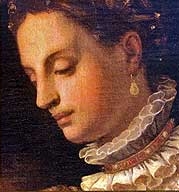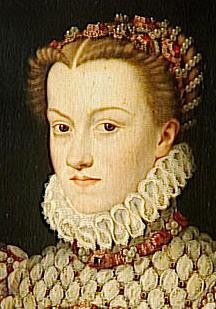Caterina de Medici was a survivor! She was born in Florence, Italy in 1562 and was raised without parents, orphaned as an infant then taken hostage during the Italian Wars. The young Duchessina (little Duchess) was wanted dead at thirteen and locked up in a convent. She cut her hair all off and wore a nun’s habit hoping it would keep people from hurting her. Thanks to her Uncle Clement, the Pope who came to her rescue, at fourteen she was betrothed to King Henry II of France. This united two of the most powerful families in Europe.
 Catherine de Medici was short and had the distinct Medici look (long nose and dark round fiery eyes). She was not beautiful but she was (and still is) unforgettable. Catherine brought many things to the French table. She was a true Renaissance Queen acquainting France to: the first high heeled shoe, the fork, underwear, the side-saddle, fortune tellers, folding fan, ice cream, artichokes and more.
Catherine de Medici was short and had the distinct Medici look (long nose and dark round fiery eyes). She was not beautiful but she was (and still is) unforgettable. Catherine brought many things to the French table. She was a true Renaissance Queen acquainting France to: the first high heeled shoe, the fork, underwear, the side-saddle, fortune tellers, folding fan, ice cream, artichokes and more.
My favorite thing that she introduced (and the reason I grew up knowing her name) is ballet! She was a huge patron of the arts and brought ballet over from Italy. Yes, ballet was originally Italian!! The Ballet Comique de la Reine was the first ballet performance and Catherine was the instigator bringing over Italian masters to choreograph the dance. The court was so impressed with the ballet that they tried to copy similar dances then eventually replaced Italian ballet masters with French, and that’s why the language of ballet became French.
Catherine had a love of architecture as well, and this can be viewed today as we appreciate the building of the Louvre and also the construction of the Tuieleries gardens.
Photos: Catherine de Medici to the left, Comique de la Reine ballet above right, and a Court ball at the Louvre below.
In addition to all of the above she had a love for astrology and was friends with Nostradamus who advised Catherine until his death. She also had a fellow Florentine, Cosimo who was her herbalist. She had a collection of potions, perfumes, and readings that she believed strongly in and sought comfort in when something seemed amiss. Catherine herself was known for having “visions” and was open to knowing the future.
King Francis I was happy to gain fourteen-year-old Catherine from Florence with her large dowry and his grand scheme of taking a chunk of Italy. The two of them got along famously because they shared a love of dance, art, and beauty. Francis actually bought the Mona Lisa from Leonardo da Vinci himself. Catherine’s father-in-law was a big influence on her artistically and politically.
Unfortunately for Catherine there was great difficulty in getting her husband Henry to come to bed with her. He had a relationship with his former older nanny, Diane de Poitiers, who held his love and heart for the rest of his life. I read that both the father-in-law and Henry’s mistress, Diane, would watch them in bed to assist in the making of an heir. Poor Catherine, can you imagine?
Ten years after Catherine and Henry were married they finally got busy and produced ten children and several heirs to the throne. Francis II (married Mary, Queen of Scots), Elizabeth (married Philip II, King of Spain), Claude (married Charles III, Duke of Lorraine), Charles IX (married Elizabeth of Austria), Henry III (married Louise of Lorraine), Margot (married and divorced Henry of Navarre, later Henry IV, King of France) and Hercules (Duke of Alencon).
Catherine’s three last children did not survive infancy. Catherine’s three sons who reigned were in constant religious war between the Catholics and the Huguenots (French Protestants). Catherine (a Roman Catholic) constantly tried to reconcile the religious groups and was trusted by neither group. She favored the Catholics but was open to making peace. That’s why she felt it important to marry Margot to Huguenot Henry, who converted twice during this war.
Once things seem to be going well for Catherine, tragedy struck again and she lost her husband in a horrible jousting accident at the wedding celebrations for their daughter Elizabeth. He lost an eye and died ten days later.
The only surviving member of the Royal Valois dynasty was Margot (Catherine’s youngest daughter) who I find to be the most fascinating of all Catherine’s children. Famous for her sense of style and beauty she was the muse of the court. She deeply loved Henry of Guise, but her mother wouldn’t allow her to marry him because the Guise family threatened to control the throne. She was forced to marry Henry II of Navarre because Catherine thought it would bring religious peace between the Catholics and Huguenots. Margot saved the lives of several Protestants, keeping them in her rooms and refusing to admit the assassins. She was famous for her scandalous behavior, taking many lovers and was imprisoned by her brother Henry III for eighteen years. She wrote her memoirs while imprisoned and later inspired Shakespeare’s comedy Love’s Labour’s Lost and Dumas’ 1845 novel and 1994 movie La Reine Margot.
Photos: Margot de Valois above right, Jeanne de Navarre to the left, and Catherine de Medici below.
As a mother, Catherine de Medici protected her children to the end, but France always came first. She was a Queen who fought for peace and was wrongly accused for some of the worst crimes: the murder of Jeanne of Navarre (Margot’s mother-in-law), the murder of Gaspard de Coligny (the Huguenot leader), poisoning her brother-in-law, and two sons, and planning the Massacre of St. Bartholomew (which killed thousands of Huguenots). 
I think of Marie Antoinette, who like Catherine de Medici was not French. Even thought they were centuries apart, the Austrian princess and Italian duchess had a lot in common (not just their sense of style). Each came to France at the age of fourteen, threatened the French culture and they were scorned for not producing an heir right away. They were also both to blame for crimes they did not commit; Marie’s “Affair of the Necklace” and Catherine’s “Massacre of St. Bartholomew.” The famous Queens’ put France first, but France failed to appreciate them; they were regarded as the enemy and wrongly misjudged.
Catherine de Medici did the best she could as a Queen and mother during her reign; she desperately wanted peace for France and some appreciation for all she had fought for. Catherine once said to the Queen of Navarre, “How sharper than a serpent’s tooth it is to have a thankless child.” This says a lot to me about the kind of person she was; a survivor who was doing the best she could in her difficult circumstance. She lived to be sixty-nine and I imagine her heart was tired, sad, and burdened by what she felt had been a “thankless” life.







